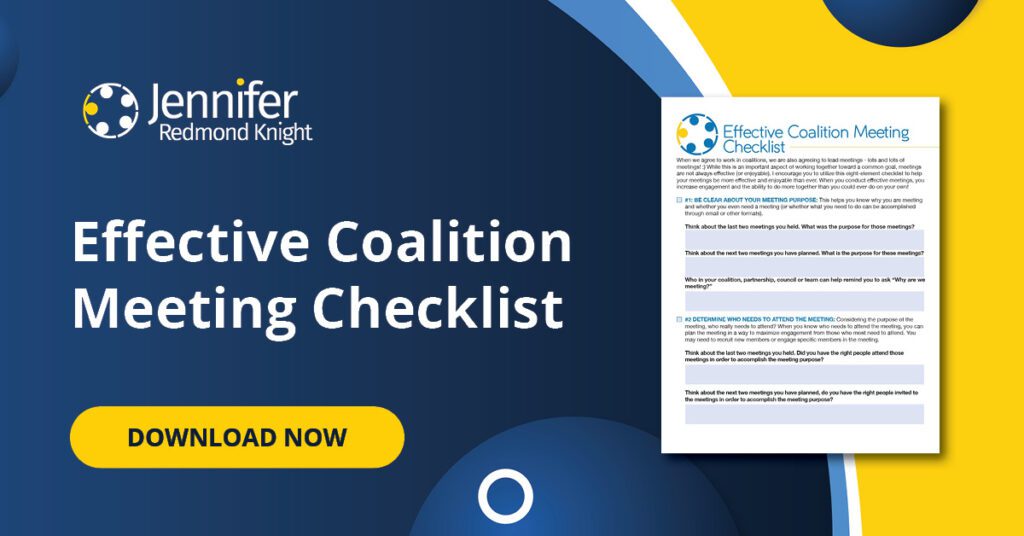In coalition meetings, we are great at informing, networking and discussing topics. Depending upon the group, sometimes, we are also great at actively working on projects, making progress toward our most important priorities and even collaborating with others. One of the areas that can be particularly challenging in any meeting – or group – is clarifying the decision making process. How will you make decisions? What is the role of the group in making decisions? Which decisions are made by the group as a whole vs. individual leaders? Join me this week as I provide three recommendations on how you can implement the meeting guiding principle: Decide on your decision making.
Consider the purpose of the group.
We are all involved in multiple types of groups and meetings for these groups. Your purpose as a coalition overall will be different from the purpose of a specific workgroup. In some situations, you may be leading or participating in groups that are advisory groups rather than action-oriented groups. I am currently supporting a group that is unclear about their purpose overall. The previous chairperson wanted to implement specific activities; however, many of the appointed group members did not feel equipped to implement the activities and struggled with how to contribute to the group. At the end of the last group meeting, I asked the question, “What is the purpose of this group? Is this an advisory group that reviews information and makes recommendations or is this an action-oriented group that implements specific activities?” The chairperson and group members did not have a clear answer and appreciated the question. Our decision at the end of that meeting was to reflect on those questions and come back ready to discuss as a group.
Determine which decisions are group decisions.
In planning a coalition meeting, there are more than 18 decisions to make (you can find these in my Effective Coalition Meeting Checklist). Clearly not every decision can be a group decision or you would always be planning meetings and never hosting them. In my early coalition-leading years, I was part of a group that wanted to meet frequently to discuss every detail and decide on every aspect of the meeting collectively before hosting each meeting. The process was painful and our partners were frustrated because we only had time to convene very few meetings a year!
Recognize the types of decisions you will need to make prior to your meeting as well as the types of decisions you expect to happen during the meeting. You may need to be deciding which priority to choose, you may be deciding the potential speakers for your next learning collaborative or you may need to decide how to implement a particular project. When you have clarity on the purpose for your group and your meeting, you are able to develop a list of the types of decisions you anticipate needing to make. Once you have this list, you can decide which of the decisions you think need to be individual leader vs. group decisions.
Plan your decision-making method(s).
Depending upon the type of decision, the size and dynamic of the group, different decision making methods are preferred. If you are making a decision on a group’s preference or experience and it is a “low-risk” type of decision, you can consider using a poll or chat question and consider the majority preference. If you are making a group decision on who is leading an effort, who is nominated to be part of a group, how much funding is being allocated or which topic will be the priority focus for a group, you will want to consider a method that allows for both discussion and a level of anonymity for the participants. If you are in person and selecting priorities, you can consider one of my favorite methods – the colored dot stickers. Each person can receive a certain number of dot stickers and can place them next to the item(s) they want to choose. There are also software tools, such as Slido, that allow people to “vote” anonymously using their phones and a QR code. For other types of decisions, you may need to discuss as a group but then send a follow-up survey or hold brief individual meetings.
Ultimately, the most important aspect of this meeting guiding principle is that you decide on your decision making. If you are part of a group that has not clearly defined the decision-making process and you continually struggle with how to make decisions, now is a great time to bring up the question: How will we decide on the decision making for this particular topic or meeting?
If you are leading meetings often and would like some additional support for leading meetings, check out my free resource, Effective Meeting Checklist.

Photo by Jens Lelie on Unsplash

